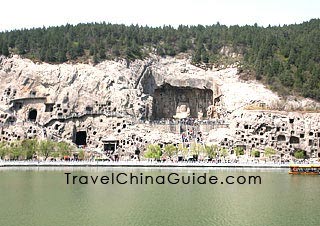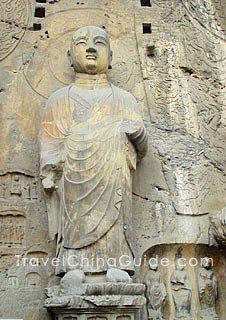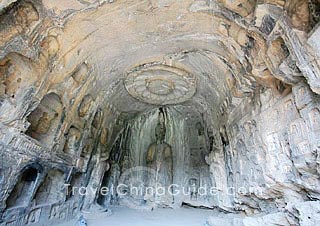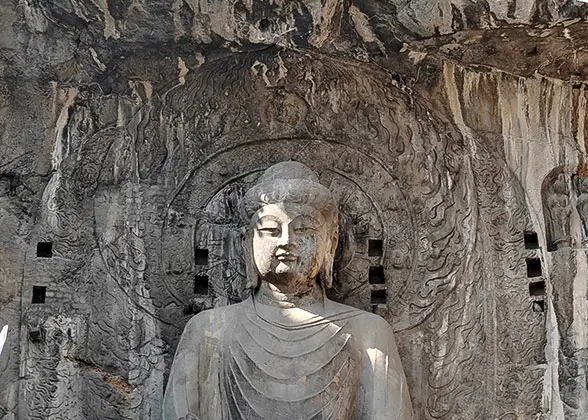Longmen Grottoes
Longmen Grottoes Facts
Length: 1,000 meters (1, 094 yards) from north to south
Construction begining: in Northern Wei Dynasty (386-534)
The Longmen Grottoes, aka Longmen Caves, are between Mount Xiang and Mount Longmen and face Yi River. Longmen Grottoes, Yungang Caves and Mogao Caves are regarded as the three most famous treasure houses of stone inscriptions in China.
Who built the Longmen Grottoes? Emperor Xiaowen of Northern Wei Dynasty firstly directed the construstion around the year 493 when he moved the capital to Luoyang. After that, the Longmen Caves were continuously built during the 400 years until the Northern Song Dynasty (960-1127). The scenery area holds over 2,300 holes and niches, 2,800 steles, 40 dagobas, 1,300 caves and 100,000 statues. Most of them are the works of the Northern Wei Dynasty and the flourishing age of the Tang Dynasty (618-907). Lots of historical materials concerning art, music, religion, calligraphy, medicine, costume and architecture are kept here.
![]() Twenty Inscriptions of Longmen Grottoes
Twenty Inscriptions of Longmen Grottoes
 |
Fengxian Temple
The most impressive figure is the statue of Vairocana Buddha sitting cross-legged on the eight-square lotus throne. It is 17.14 metres (about 56.23 feet) in total height with the head four metres (about 13 feet) in height and the ears 1.9 metres (about 6.2 feet) in length. Vairocana means illuminating all things in the sutra. The Buddha has a well-filled figure, a sacred and kindly expression and an elegant smile. According to the record on the epigraph, the Empress Wu Zetian together with her subjects took part in the ceremony of Introducing the Light (a Buddhist blessing that the Buddha opens the spiritual light of himself and shares it with others).
At the sides of Vairocana there are two statues of Vairocana Buddha's disciples, Kasyapa and Ananda, wearing prudent and devout expressions. The figures of Bodhisattvas and devas can also be found in the temple. Some have dignified and genial expressions, while others are majestic and fiery. The various appearances and delicate designs are the representations of Empire Tang's powerful material and spiritual strength as well as the high crystallization of people's wisdoms.
 |
Wanfo Cave
In addition, there are lifelike reliefs of pretty and charming singers and dancers on the wall. The singers are accompanied by various kinds of instruments and the dancers dance lightly and gracefully to the music. The whole model in the cave has created a lively and cheerful atmosphere. On the southern wall outside the cave is carved a statue of Kwan-yin of 85 centimetres (about 33 inches) in height, holding a pure bottle in the left hand and deer's tails (as a symbol of brushing off the dust in spirit) in the right hand. This figure is well designed and is regarded as an example of Bodhisattva statues of Tang Dynasty in Longmen.
Guyang Cave
|
|
Binyang Cave
Lotus Cave (Lianhua Cave)
In addition, there is Prescription Cave that has about 140 prescriptions engraved on the walls, showing the achievements of medicine in ancient China. Some of the prescriptions are still used today. Other caves and temples like Xiangshan Temple, Huangfugong Cave, and Qianxi Temple can also be found in Longmen Grottoes.
How to get to Longmen Grottoes from Luoyang
Take Bus 53/ K53, 60/ K60, 71, 81/ K81, 99/ K99, or 167 to Longmen Shiku (Longmen Grottoes) Station.
2. From Luoyang Railway Station:
By Bus: take bus no. K81 and get off at the last station.
By Taxi: it costs around CNY 35 to 40.
3. From Longmen Railway Station:
By Bus: take bus no. 71 and get off at Longmen Shiku Station.
By Taxi: it costs around CNY 15
How to get to Longmen Grottoes from Xi'an
How to get to Longmen Grottoes from Beijing
| Entrance Fee | CNY 90(including grottoes on East and West Hills, Xiangshan Temple and Bai Garden); Free for children below 1.2 meters (3.9 feet). |
|---|---|
| Opening Hours | Feb. & Mar.: 08:00 - 18:00 Apr. 1 - Oct. 7: 08:00 - 18:30 Oct. 8 - 31: 08:00 - 18:00 Nov. - Jan.: 08:00 - 17:00 1. Ticket sale ends an hour before the closing time. 2. During the May Day Holiday and National Day Holiday (Oct. 1 to 7), and on Friday, Saturday and Sunday during Luoyang Peony Culture Festival, it opens 30mins earlier and closes 30mins later. |
![]() 9 Historical Places in China You Should Never Miss
9 Historical Places in China You Should Never Miss![]() Recommended Guided Tours to Longmen Grottoes:
Recommended Guided Tours to Longmen Grottoes:
Luoyang 3 Days Tour from $349
1 Day Bullet Train Tour to Luoyang from Xi'an from $189
- Last updated on Aug. 08, 2025 by Demi Li -


